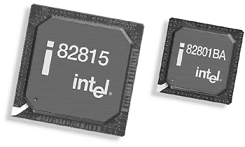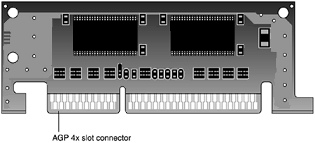Intel 815 Family Chipset
Introduced in June 2000, the 815 and 815E chipsets are mainstream PC chipsets with integral video that is also upgradable via an AGP 4x slot. An 815EP version introduced a few months later lacks the integrated video for lower cost. In March 2001, the 815P chipset, an improved version of the 815EP, was introduced.
In September 2001, the last members of the family—the 815G and 815EG—were introduced. Note that the G indicates that these chipsets also include integrated video. The 815 chipsets are designed for Slot-1 or Socket-370 processors, such as the Celeron or Pentium III.
These are the first chipsets from Intel designed to directly support PC133 SDRAM memory, allowing for a more affordable solution than other chipsets using RDRAM memory. Similar to the other 8xx series chipsets from Intel, the 815 uses hub architecture that provides a 266MBps connection between the main chipset components and does not share the PCI bus like the prior North/South Bridge designs.
Although six variations on the 815 chipset are available, only five different parts are used to create the various members of the family: one memory controller hub (82815EP MCH: North Bridge replacement without integrated graphics), two graphics memory controller hubs (82815 or 82815G GMCH: North Bridge replacement with integrated graphics), and two I/O controller hubs (ICH and ICH2).

All 815 chipsets support the following features:
-
66/100/133MHz system bus
-
266MBps hub interface
-
ATA-100 (815E/EP/EG) or ATA-66 (815/P/G)
-
PC100 or PC133 CL-2 SDRAM (also PC66 with 815G/GE)
-
Up to 512MB RAM
-
Integrated Audio-Codec 97 (AC97) controller
-
Low-power sleep modes
-
RNG for stronger security products
-
One (815/P/G) or two (815E/EP/EG) integrated USB controllers with either two or four ports, respectively
-
LPC bus for Super I/O and Firmware Hub (ROM BIOS) connection
-
Elimination of ISA Bus
The 815/E/G/EG also support the following:
-
Integrated Intel AGP 2x 3D graphics
-
Efficient use of system memory for graphics performance
-
Optional 4MB of dedicated display cache video memory
-
Digital Video Out port compatible with DVI specification for flat panel displays
-
Software MPEG-2 DVD playback with hardware motion compensation
The 815E/EP/EG uses the ICH2, which is most notable for providing ATA-100 support, allowing 100MBps drive performance. Of course, few drives can really take advantage of this much throughput, but in any case, there won't be a bottleneck there.
The other notable feature is having two USB 1.1 controllers and four ports on board. This allows double the USB performance by splitting up devices over the two ports and can allow up to four connections before a hub is required.
Integrated Ethernet
Another important feature of the 815 series is the integration of a fast Ethernet controller directly into the chipset. The integrated LAN controller works with one of three new physical layer components from Intel and enables three distinct solutions for computer manufacturers. These include
-
Enhanced 10/100Mbps Ethernet with Alert on LAN technology
-
Basic 10/100Mbps Ethernet
-
1Mbps home networking
These physical layer components can be placed directly on the PC motherboard (additional chips) or installed via an adapter that plugs into the CNR slot. The CNR slot and cards enable PC assemblers to build network-ready systems for several markets.
AGP Inline Memory Module
Although the 815/815E feature is essentially the same built-in AGP 2x 3D video that comes with the 810 chipset, the difference is upgradeability. The video can easily be upgraded by adding a graphics performance accelerator (GPA) card or an AGP 4x card for maximum 3D graphics and video performance.

The GPA card (also called the AGP Inline Memory Module, or AIMM) is essentially a high-performance video memory card that works in the AGP 4x slot and improves the performance of the integrated video by up to 30%. Unfortunately, these are not commonly sold and are somewhat expensive.
For even more performance, you can install a full 4x AGP card in the AGP 4x slot, which disables the integrated video. By having the video integrated, very low-cost systems with reasonable video performance can be assembled. By later installing either the GPA or a full 4x AGP card, you can improve video performance up to 100% or more.
PC133 Memory Support
Another important feature of the 815 chipset is the support of PC133 memory. The 815 family also uses PC100 memory. With PC133 support, Intel has also officially set a standard for PC133 memory that was higher than some of the PC133 memory on the market at the time of introduction.
To meet the Intel PC133 specification, the memory must support what is called 2-2-2 timing, sometimes also known as CAS-2 (column address strobe) or CL-2 timing. The numbers refer to the number of clock cycles for the following functions to complete:
-
Precharge command to Active command. Charges the memory's storage capacitors to prepare them for data
-
Active command to Read command. Selects rows and columns in memory array for reading
-
Read command to Data Out. Reads data from selected rows and columns for transmission
Some of the PC133 memory on the market takes three cycles for each of these functions and would therefore be termed PC133 3-3-3, CAS-3, or CL-3 memory. Note that the faster PC133 CL-2 can be used in place of the slower CL-3 variety, but not the other way around.
As a result of the tighter cycling timing, PC133 CL-2 offers a lead-off latency of only 30ns, instead of the 45ns required by PC133 CL-3. This results in a 34% improvement in initial access due to the decreased latency.
The 815 chipset was a popular chipset for the mainstream PC market that didn't want to pay the higher prices for RDRAM memory. The 815 was essentially designed to replace the venerable 440BX chipset.